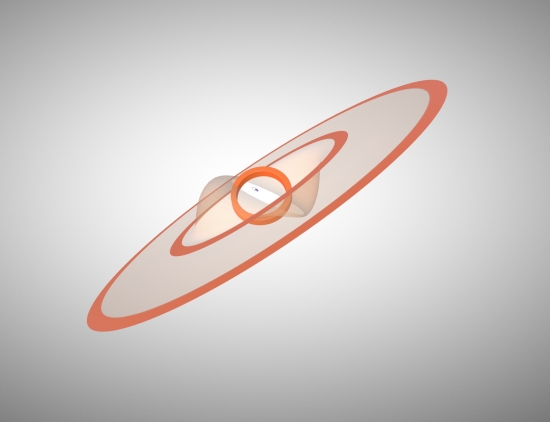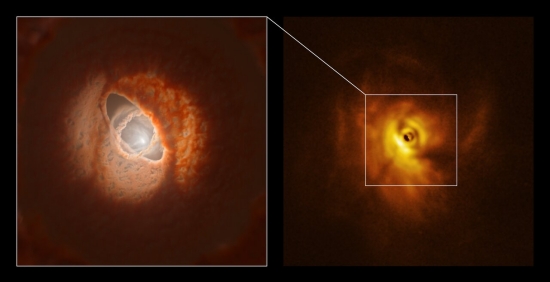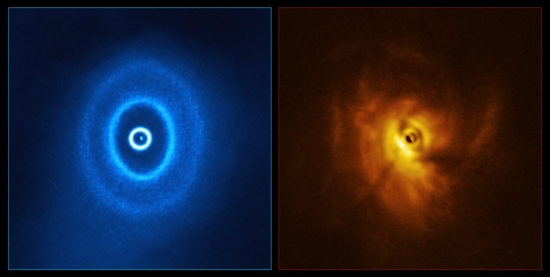This morning we have two interesting and complementary studies of GW Orionis to look at, both analyzing what is apparently a planet-forming disk with multiple, misaligned rings around this triple star system some 1300 light years from the Sun. In the more recent of the two, Stefan Kraus (University of Exeter) and colleagues used data from both the Atacama Large Millimeter/submillimeter Array (ALMA) and the European Observatory’s Very Large Telescope (VLT) in detecting warm gas at the inner edge of the misaligned ring, which has broken away from the larger disc, and scattered light from the warped disk surface.
So what could be going on at GW Orionis? What the images reveal is an evolving young system much different from our own. Consider: The inner stars GW Ori A and GW Ori B orbit each other at a separation of a scant 1 AU, while the third star, GW Ori C, orbits the inner stars at a distance of roughly 8 AU, the latter in an orbit that is not aligned with the plane of the inner duo. In our Solar System, we’re used to planets that move in roughly the same plane around the Sun. Here we see a deformed protoplanetary disk that may produce an utterly different result.

Image: Representation of the disc structure and stellar orbit of the GW Orionis triple system, as derived from the ALMA and VLT observations by Kraus et al. Orange rings are the (misaligned) rings seen by ALMA. The transparent surfaces correspond to the lower-density dust filaments that connect the rings and that dominate the emission in scattered light. Credit: Kraus et al., 2020; NRAO/AUI/NSF.
What an intriguing place to study planet formation, and to ponder scenarios as the system evolves. The ALMA data reveal three separate rings with different orientations, located at 46, 185 and 340 AU from the barycenter of the system. The inner ring is misaligned in relation not only to the outer two rings but also to the three stars. Says Kraus:
“In our images, we see the shadow of the inner ring on the outer disk. At the same time, ALMA allowed us to measure the precise shape of the ring that casts the shadow. Combining this information allows us to derive the 3-dimensional orientation of the misaligned ring and of the warped disk surface.”

Image: New observations of GW Orionis, a triple star system with a peculiar inner region, revealed that this object has a warped planet-forming disk with a misaligned ring. The image on the right is from the SPHERE instrument on the European Southern Observatory’s Very Large Telescope, which allowed astronomers to see, for the first time, the shadows this ring casts on the rest of the disk. This helped the researchers figure out the 3D shape of the ring and the overall disk. The left panel shows an artistic impression of the disk’s inner region, including the ring, which is based on the 3D shape reconstructed by the team. Credit: ESO/L. Calçada, Exeter/Kraus et al.
Planets could well emerge here, with the research indicating that the inner ring contains about 30 Earth masses of dust. What’s intriguing is that any planets forming within this inner ring will orbit in a highly oblique fashion at wide separation from the star. Bear in mind that it’s now believed that more than half of the stars in the galaxy are born with one or more companion stars, making for the prospect of a large population of planets on highly inclined, distant orbits.
Kraus and team have been examining GW Orionis for over 11 years, mapping the gravitational interactions at work among the three stars over a full orbital period. It is clear that the stellar orbits are misaligned from each other and from the disk. We’re getting confirmation here through both observations and computer simulations that a theoretical ‘disk tearing effect’ is in play, one that emerges out of the gravitational pull of the three stars and causes the disk to break into separate rings. Observation of the shadow that the inner ring casts upon the rest of the disk was useful in calculating the shape of the ring and the overall disk structure. Moreover, the shape of the inner ring matches predictions of precisely how gravitational interactions would tear the original disk.

Image; ALMA and the SPHERE instrument on ESO’s Very Large Telescope have imaged GW Orionis, a triple star system with a peculiar inner region. Unlike the flat planet-forming discs we see around many stars, GW Orionis features a warped disc, deformed by the movements of the three stars at its centre. The ALMA image (left) shows the disc’s ringed structure, with the innermost ring separated from the rest of the disc. The SPHERE observations (right), repeated here for comparison, allowed astronomers to see for the first time the shadow of this innermost ring on the rest of the disc, which made it possible for them to reconstruct its warped shape. Credit: ALMA (ESO/NAOJ/NRAO), ESO/Exeter/Kraus et al.
The second team, led by Jiaqing Bi (University of Victoria, Canada), likewise used data from ALMA to observe the same disk misalignment, publishing their paper in May. This work confirms that the inner ring is misaligned relative to the outer ring and the three stars, with the outer ring being the largest yet observed in disks of this kind. Both teams used computer simulations to examine causes for the misalignment, with the Bi team suggesting a possibility that does not arise in the Klaus paper. This is team member Nienke van der Marel (University of Victoria):
“Our simulations show that the gravitational pull from the triple stars alone cannot explain the observed large misalignment. We think that the presence of a planet between these rings is needed to explain why the disk was torn apart. This planet has likely carved a dust gap and broken the disk at the location of the current inner and outer rings.”
Such a planet would be the first ever observed to orbit three stars. Moreover, it’s clear from the example of GW Orionis that stellar groupings like this can play havoc with the shape of a protoplanetary disk, doubtless producing worlds in highly inclined orbits around multiple stars. “We predict that many planets on oblique, wide-separation orbits will be discovered in future planet imaging campaigns,” says Kraus co-author and Exeter colleague Alexander Kreplin.
The paper is Kraus et al., “A triple star system with a misaligned and warped circumstellar disk shaped by disk tearing” Science Vol. 369, Issue 6508 (4 September 2020), pp. 1233-1238 (abstract). The Bi paper is “GW Ori: Interactions Between a Triple Star System and Its Circumtriple Disk in Action,” Astrophysical Journal Letters Vol. 895, No. 1 (21 May 2020), Abstract.



Just how stable could that hypothetical planet between the inner 2 rings be? Planets forming in the outer rings are far from the suns, suggesting that they are very cold. Gas giants? Ice giants? Dwarf icy worlds like Pluto?
Looking at the system of rings and their diameters, began to wonder what how big the triple system stars were. Had access to one of the reports (Science). Quoting below:
“Fitting an orbit model to these observations results in tight constraints on the masses of the three stars
GW Ori A, 2.47 ±0.33 solar masses;
GW Ori B, 1.43 ± 0.18 solar masses; and
GWOri C, 1.36 ± 0.28 solar masses …
“The orbits of the inner pair (A-B) and the tertiary
(AB-C) are tilted 13.9 ± 1.1° from each other.”
====
The triple system provides a lot of candle power, but I suspect that
50 AUs would still be a chilly region for building a planet – in radiative terms from point sources. But with all those clouds, you might need to consider all their reflectivity as well.
When one speaks of stability, I believe most disks in planetary studies come under ten million years. If there are unstable disks here, then they would survive for shorter terms?
I haven’t done these calculations before, but it will be fun to try:
absolute magnitude [M] = relative magnitude – 5 log10 (d/10 pc)
From Wikipedia, the relative magnitude is 9.7 to 10.4; I’ll call it 10 because I’m not pretending accuracy. The distance is 400 pc. So M = 10 – 5 log10(40) = 5 – 5 log10(4) = 2. The Sun’s absolute magnitude is 4.83, so this system is 10^(2.83/5) times brighter = 3.7 times brighter. So if we approximate a point source for all the light, an Earthlike habitable zone ought to be a little less than 2AU out. At this point the approximation breaks down since the stars themselves are further apart than that. Also, with the three stars adding up to more than 4 solar masses I feel quite skeptical of the number I have – likely the extinction can’t be neglected in a system with such lovely rings and visible shadows! Even so, well, the result I came up with was that 50 AU would be less than 1/600 the light the Earth receives from the Sun, so I’d have to be off by quite a bit indeed for it to be an Earthlike planet or moon. Such a young planet must have some impressive hot springs, at least… and a view to die for.
M. S.,
You know, this system is just going to lure people in. I think what will happen is someone will make an assumption, then a calculation, look at it for a minute – and then go to another level of detail.
I just tried something different, but also approximate. With 3 stars dispersed as they are, I am assuming that their luminosities can be treated as additive, e.g., for a planet orbiting all three. But the trouble is, their respective distances to
a putative planet is going to be shifting due to cyclic motions.
It would help if the HZ could be considered far enough away that all three could be considered at about the same distance away, but my calculations thus far indicate not.
If we were to take mass-luminosity relation as power 3.5 we would have solar luminosities of 23.7, 3.5 and 2.93. Adding up to 30.12.
For Earth’s distance from the sun and you stretch the sun’s effective surface out to 1 AU, that’s about 400 K. A combined luminosity equivalent would be about 5.47 AUs. That’s too close to treat the three stars as a cluster in the same part of the sky. Secondly, I am not sure that the phase of stellar development where rings abide calibrates to the main sequence mass luminosity relation I invoked.
What could be done?
Well, how about if we reduce absolute temperature to 300 K or 3/4?
That sets things off to about 9.7 AUs. Tempted to say, “getting closer”, but what we need is the opposite. As noted above, in this layer cake, A and B orbit each other at 1 AU and C is out at about 8.
Maybe a Lagrangian point would work, but for these mass ratios, I suspect that they are not serviceable.
With a Sirius sized star, that main sequence lifetime we equate to the sun might translate to about 400 million years, which would mean more action and flareup. What’s more, A and B are the relatively close binaries.
So, if we are talking habitable zones, maybe placing a planet in orbit about C at 1.7 AU or more (for the lower effective temperature) would be a solution to the HZ problem. A and B would be at arm’s length thermally – until A has trouble with its hydrogen feed line.
I went to the Wikipedia article for mass-luminosity relation – their set of formulae get me to 37.6 times the luminosity of the Sun, versus the 3.7 that I came up with above. Now part of that is that the luminosity range I read was probably variation rather than uncertainty; if I start with 10.4 that gets me up to 4.4 … still, we’re seeing less than 1/8 the light we should. It’s not just the pretty rings, either: according to https://astronomy.stackexchange.com/questions/25868/what-does-this-figure-imply-about-the-luminosity-of-pre-main-sequence-stars the luminosity is going to depend on mass and age and a pre main sequence star isn’t going to follow rules meant for stars with stable fusion. I have a nagging suspicion an age we look up is going to turn out to have been calculated from the absolute magnitude…
If the stars really are that dim, a planet orbiting one of them could be closer to it – maybe it’s less likely we have to call the _Dark Star_ to stop it from fouling up our 50 AU pleasure dome in the ice. :)
Imagine the view from that planet.
It would be most likely a gas giant which would have the biggest gravitational effect on the dust rings. The planet would be stable, but it could tear a ring of dust apart if the orbital angle is oblique or misaligned. The instability would be inside the orbit of the outer star at only 8 AU.
What surprised me about this system is has three stars, but still has gas rings. I thought the inside of the double star system might be unstable so planets couldn’t form there because the ring theory formation of double star systems grabs all the gas and angular momentum so there is none is left over for planets , but I never thought there might be planets on the outside of the orbit of the outer star at 8 AU. The outer rings would be very cold as Allex Tolley wrote so there might not be any planets in the life belt. 46 AU is close to Pluto’s aphelion so a triple star system would look like three stars close to each other, but if a planet could or did form within or near 8 AU, the view would be unusual as already mentioned.